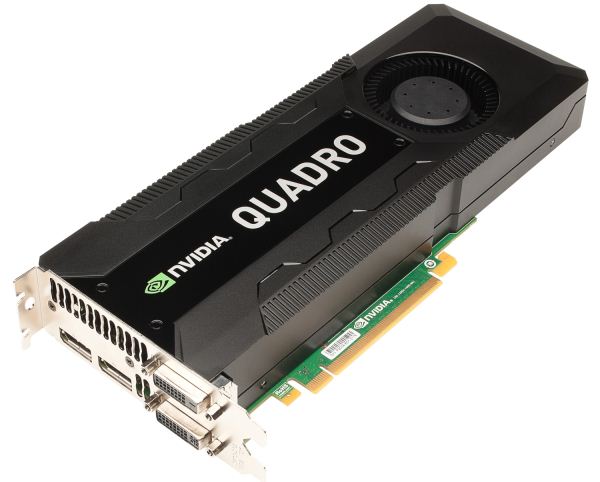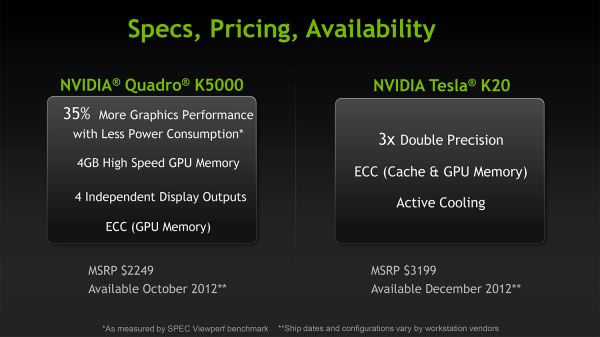NVIDIA Announces Kepler-Based Quadro K5000 & Second-Generation Maximus
by Ryan Smith on August 7, 2012 10:00 AM ESTSince the initial launch of NVIDIA’s unusual chip stack for Kepler in late March, there has been quite a bit of speculation on how NVIDIA would flesh out their compute and professional products lines. Typically NVIDIA would launch a high-end GPU first (e.g. GF100), and use that to build their high-end consumer, professional, and compute products. Kepler of course threw a wrench into that pattern when the mid-tier GK104 became the first Kepler GPU to be launched.
The first half of that speculation came to rest in May, when NVIDIA has announced their high-end Kepler GPU, GK110, and Tesla products based on both GK104 and GK110. NVIDIA’s solution to the unusual Kepler launch situation was to launch a specialized Tesla card based on GK104 in the summer, and then launch the more traditional GK110 based Tesla late in the year. This allowed NVIDIA to get Tesla K10 cards in the hands of some customers right away (primarily those with workloads suitable for GK104), rather than making all of their customers wait for Tesla K20 at the end of the year.
Meanwhile the second half of that speculation comes to an end today with the announcement of NVIDIA’s first Kepler-based Quadro card, the Quadro K5000.
| Quadro K5000 | Quadro 6000 | Quadro 5000 | |
| Stream Processors | 1536 | 448 | 352 |
| Texture Units | 128 | 56 | 44 |
| ROPs | 32 | 48 | 40 |
| Core Clock | ~700MHz | 574MHz | 513MHz |
| Shader Clock | N/A | 1148MHz | 1026MHz |
| Memory Clock | 5.4GHz GDDR5 | 3GHz GDDR5 | 3GHz GDDR5 |
| Memory Bus Width | 256-bit | 384-bit | 320-bit |
| Frame Buffer | 4GB | 6GB | 2.5GB |
| FP64 | 1/24 FP32 | 1/2 FP32 | 1/2 FP32 |
| Max Power | 122W | 204W | 152W |
| Architecture | Kepler | Fermi | Fermi |
| Transistor Count | 3.5B | 3B | 3B |
| Manufacturing Process | TSMC 28nm | TSMC 40nm | TSMC 40nm |
The Quadro K5000 is the Kepler-based successor to NVIDIA’s existing Fermi-based Quadro 5000 video card. Based on the same GK104 GPU as NVIDIA’s Tesla K10 and GeForce GTX 680, the card is in many ways the near-obligatory workstation version of NVIDIA’s existing consumer products. Based on the theoretical performance numbers provided by NVIDIA, Quadro K5000 uses a fully enabled GK104 GPU clocked at around 700MHz core, and is paired with 4GB of VRAM operating at 5.4GHz. Meanwhile NVIDIA has the max power consumption of the card listed at an incredibly low 122W, which given the low core clockspeed of the card indicates that NVIDIA was able to significantly reduce GK104’s power consumption by reducing its clockspeed by such a large degree.
For NVIDIA the Quadro K5000 is the most significant new Quadro card in quite some time and is this way for many of the same reasons that the GeForce GTX 680 was a major card for NVIDIA’s consumer graphics division. The jump to TSMC’s 28nm process along with the Kepler architecture has greatly improved NVIDIA’s power efficiency, with NVIDIA’s graphics performance increasing while at the same time their power consumption has been greatly reduced.
Meanwhile Quadro K5000 also brings with it all of the major Kepler family features that we first saw with the GeForce GTX 680, including support for DisplayPort 1.2, 4 display controllers per GPU, PCI-Express 3.0 support, the NVENC H.264 video encoder, and even bindless textures. The additional display functionality in particular will likely have the greatest impact for Quadro users, especially those who are intending to drive 4k monitors or who are already driving 3+ monitors by using multiple Quadro cards. This also means that NVIDIA can now support up to 16 monitors off of a single system by using 4 Quadro K5000 cards, with the ability to keep them genlocked using Quadro Sync functionality.
As for matters of performance, Intel Sandy Bridge-E workstation owners will be happy to hear that PCI-Express 3.0 should also make its presence felt. Unlike the GeForce 600 series NVIDIA will be enabling PCIe 3.0 for qualified SNB-E workstations, which will improve performance in situations where the PCIe bus is the bottleneck.
Meanwhile we expect that NVIDIA’s bindless texture feature to finally get some real attention with the K5000, after having been largely ignored on their consumer cards. Because bindless textures are currently only available via OpenGL and because OpenGL has a much greater presence in the professional market as opposed to the consumer market, there should be enough interest on the software side for this functionality to be put to meaningful use.
Wrapping things up, professional users looking to pick up a Quadro K5000 will want to pay close attention to their wallets and their calendars. Quadro K5000 is set to ship individually in October for $2249, or together with the Tesla K20 as part of second generation Maximus systems in December.
Finally, as with the Tesla K10 there’s the question of what to make of NVIDIA releasing a professional product based on what is otherwise a mid-range GPU. GK104’s strengths and weaknesses haven’t changed – it’s still strong at graphics and picky about compute performance – but unlike Tesla K10 NVIDIA doesn’t necessarily need strong compute performance here as the Quadro line is first and foremost for professional graphics. Still, compared to the Quadro 5000 it replaces the K5000 is losing quite a bit of double-precision compute performance along with some ECC memory protection (GK104 lacks ECC for its caches), so NVIDIA has clearly had to make some trade-offs to get a Kepler Quadro card released in October of this year as opposed to next year when more GK110 GPUs become available. Thankfully for NVIDIA they don’t necessarily need strong compute performance from their Quadro cards so long as they have Maximus.












29 Comments
View All Comments
unidntifiedbones - Wednesday, August 8, 2012 - link
Look again, Gee Bee R1, not I-16.Bit of a silly image really.
HisDivineOrder - Wednesday, August 8, 2012 - link
"Meanwhile Quadro K5000 also brings with it all of the major Fermi family features that we first saw with the GeForce GTX 680, including support for DisplayPort 1.2, 4 display controllers per GPU, PCI-Express 3.0 support, the NVENC H.264 video encoder, and even bindless textures."You said "major Fermi family features," but did you mean Kepler?
Ryan Smith - Wednesday, August 8, 2012 - link
Yes, I did. Thank you for that.shawkie - Wednesday, August 8, 2012 - link
Any idea how they've managed to make PCI-Express GEN3 work with SNB-E on this board and not on the GTX 600 series? Have they managed to respin the GK104 already? Or have they used a bridge chip like on the GTX 690? Or is it just down to the track layout on the PCB?BTW, I'm aware that its possible to force the driver to run in GEN3 with SNB-E even with the GTX 600 series but in my experience this doesn't actually work properly (slow transfer speeds and system instability) so I can't imagine nVidia would suddenly claim it was supported unless they've actually changed something.
Ryan Smith - Wednesday, August 8, 2012 - link
While I don't have the full details, it doesn't look like NVIDIA has actually changed anything. Rather Kepler and SNB-E working correctly with PCIe 3.0 is dependent on some (unknown to us) hardware factor on the host machine. NVIDIA knows what that factor is, and will be qualifying workstations for PCIe 3.0.As it stands we know that PCIe 3.0 works perfectly fine on some SNB-E systems (namely: ours), so this isn't all that hard to believe.
shawkie - Wednesday, August 8, 2012 - link
So logically if a workstation is qualified by nVidia for PCIe 3.0 with the K5000 then we should expect that workstation to also work (in GEN3 mode) with the GTX 600 series...So far nVidia have repeatedly refused to publish any kind of list of qualified PCIe 3.0 motherboards claiming that results also vary by CPU (among other factors?).
Ryan Smith - Wednesday, August 8, 2012 - link
Correct, if it were to be qualified with K5000 then it should also work with a manually enabled GTX 600 card.pvrvideoman - Wednesday, August 8, 2012 - link
Reading these articles on Kepler products makes me think that sticking to the Fermi products would be a better, less expensive choice. They are well established, and are valuable in many applications. Check out RenderStreamTV on Youtube. This isn't the only video where the power of the mainstream GPU is utilized in an app, but it's a nice one. The consumer and the manufacturer have such different goals. AMD seems to have the consumer in mind a bit more than NVidia.Rictorhell - Wednesday, August 8, 2012 - link
What I am trying to find out is if there is the possibility of Nvidia releasing a newer, more powerful graphics card later this year or early next year, or if the GTX 690 is it, as far as consumer cards, for the near future?I haven't purchased a new graphics card for a few years, so I want the best, but most power efficient card that I can buy. The impression I have is that the 680 and the 690 are great cards, but that they don't really provide a "huge" power boost over the previous generation cards or the cards just prior to that generation.
If they are planning to release something that is significantly faster then the 680, I would definitely be interested in that, if it's coming.
Rictorhell - Wednesday, August 8, 2012 - link
The last card that I purchased was the Geforce 8800 GTX. Is there anyone here that had that card or has that card, that can tell me, roughly, how the performance of that card would compare to the peformance of the GTX 680?